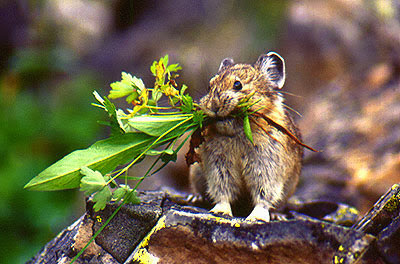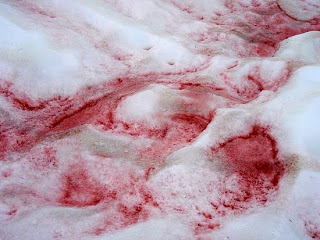Biology concepts – subnivean zone, chionophiles, antifreeze proteins, UV vision, snow blindness, photokeratitis
Hogg C, Neveu M, Stokkan KA, Folkow L, Cottrill P, Douglas R, Hunt DM, & Jeffery G (2011). Arctic reindeer extend their visual range into the ultraviolet. The Journal of experimental biology, 214 (Pt 12), 2014-9 PMID: 21613517
Kondo H, Hanada Y, Sugimoto H, Hoshino T, Garnham CP, Davies PL, & Tsuda S (2012). Ice-binding site of snow mold fungus antifreeze protein deviates from structural regularity and high conservation. Proceedings of the National Academy of Sciences of the United States of America, 109 (24), 9360-5 PMID: 22645341
Pentelute BL, Gates ZP, Dashnau JL, Vanderkooi JM, & Kent SB (2008). Mirror image forms of snow flea antifreeze protein prepared by total chemical synthesis have identical antifreeze activities. Journal of the American Chemical Society, 130 (30), 9702-7 PMID: 18598026
Kuwabara C, Takezawa D, Shimada T, Hamada T, Fujikawa S, & Arakawa K (2002). Abscisic acid- and cold-induced thaumatin-like protein in winter wheat has an antifungal activity against snow mould, Microdochium nivale. Physiologia plantarum, 115 (1), 101-110 PMID: 12010473
This leads a biologist to ask, "Just who and what is depending on the snow; how does snow affect the living world?" Many animals have snow in their name, but that isn’t always a good clue. The snowy egret and the snow crab are examples.
The snowy egret is called that only because of its white plumes, while the snow crab is so named because its hunting season is when the snow is the deepest. Mike Rowe, the hardest working man in show business since James Brown, taught watchers of The Deadliest Catch that the snow crab is better called the opilio crab (Chionoecetes opilio). Fisherman that go to sea to put them on your table are a breed unto themselves.
Egrets and crabs don’t help us to investigate the question of the effects of snow on life. The easy observation is that snowy winters are something that organisms have evolved to overcome or even use to their advantage. They have developed ways to survive the harsh conditions of the snowy season or to exploit the white stuff.
On the other hand, their markings are better suited for their preferred living and hunting grounds. They aren’t nearly as white as you would expect. They like to live on rocky ledges and they descend into the forests to hunt prey when the weather gets really cold (because that’s where the prey are), so their brown tints and spots help them blend in to both habitats.
The lemming is an example of a small mammal that exploits the snow for cover, others being mice, voles, and shrews. The Norway lemming (Lemmus lemmus) moves from the low mountainsides up to higher elevations (opposite of the snow leopard for obvious reasons) as the snow falls. They don’t live underground, although they may nest there, but they don’t live on top of the snow either.
The lemmings dig vast networks of tunnels in the snow where it meets the ground. This is called the subniveanenvironment (sub = below, and niveus is Latin for snow), and they race around looking for vegetation to eat and other lemmings with which to mate. The many openings in the snow may seem to be doors to the subnivean environment, but the lemmings rarely come out of the snow. They are more likely vents to release carbon dioxide from lemming breath and plant decomposition.
Some animals, like some big cats and large owls have evolved a hearing sense that allows them to pinpoint lemmings under the snow, but the subnivean tunnels work well enough that lemming populations usually skyrocket every 3-4 years, and then plummet as resources become scarce. Their success is in some ways their downfall.
And speaking of falling, the lemmings are also responsible for some human tragedies. When the temperatures fluctuate and the tunnels remodel with ice and snow, the layers of snow can become unstable. The dense snow above the tunnel system will crush and slide off the subnivean layer and …. look out below, here comes the avalanche. And I thought skiers that flock to resorts in order to fall off the mountain repeatedly were the lemmings!
You wouldn’t expect it, but some small arthropods (insects and such) have found ways to live in the snow. When a warmer winter day pops up, so do the snow fleas (Hypogastrura nivicola). You will see them as black specks on the snow – appearing in the thousands at the bases of trees. They aren’t really fleas at all, but a species of springtail (see picture). The reason they come out is not known exactly, but I think that any snow melt due to warmth might drown them in their below ground hiding places.
Snow fleas have an antifreeze protein that keeps them alive over the winter. This isn’t an exception, many animals have chemical mechanisms to prevent freezing, but the protein in snow fleas is unlike any other. The snow flea anti-freeze protein (sfAFP) may serve humans as well. See the post here for more on anti-freezing mechanisms, and here to show that snow midges are the largest animals in many parts of cold Antarctica.
A 2008 project produced the protein in a laboratory and showed that it may be possible to use it to preserve organs for transplant a longer time. Storage at cooler temperatures would allow for longer shelf lives for organs, but they can become damaged by ice crystal formation. The researchers also made a version of the protein using D-amino acids. We have talked about these before – but here they work to our advantage, by making the protein less susceptible to enzymatic degradation, while still providing antifreeze function.
Snow melt mosquitoes, on the other hand, are winged. Living from northern California up to the arctic tundra, snowpool Aedes mosquitoes (many species) lay their eggs and their larvae develop in the pools of melted snow as the weather warms. This gives them a head start on the rest of the mosquito world. It would seem many forms of life have found ways to exploit snow.
Then there are the chionophiles(chioni is Greek for snow, and phile = lover). We have talked about the psychrophiles, organisms that prefer cold temperatures, but chionophiles need the snow to survive.
It may seem counterintuitive, but many organisms need the snow to keep them warm. It’s the wind that blows heat away from around the skin, so a layer of snow actually helps trap heat and protect form the wind. Lemmings give snow a big thumbs up (if they have thumbs) for snow as an insulator.
It isn’t just animals that need a “blanket” of snow to retain heat and protect from the wind. Winter wheat needs the snow, but for several reasons. Sure, the snow provides insulation for the young shoots that were planted in the late fall and go dormant until the spring. Nothing worse than frozen wheat.
But the snow also provides a source of water when it melts. This loosens the ground to give the wheat plants strength to push through the earth, and for early water for growth. Snow also gives stability to the young plants out on the plains. Lots of wind out there, enough to knock down and break the fragile plants when they are young. A cast of snow surrounding the stem helps keep them upright. The wise man says, “ Rain versus snow, the wheat doesn’t know the difference, but the farmer wants snow in the winter.”
Snow mold doesn’t attack plants on exposed soil – but they may be killed by the more extreme temperature. They do attack where there is snow, and there is more damage in the deeper snow banks – it seems they do their damage under cover of snow only – more snow, longer time for complete melt, more damage.
The snow mold excretes its antifreeze proteins, not to prevent itself from freezing, but to keep ice crystals from forming or altering around the fungus. Perhaps they are protecting their food to keep it growing and a good source of nutrients; often that food is wheat. But wheat also has tricks. A 2002 study shows that winter wheat produces several proteins that inhibit the growth of the mold.
Now back to Rudolph. To understand his exception with snow, we first need to talk about photokeratitis(photo = light, keratin = the protein found in cornea, and it is = inflammation), better known as snow blindness. For Eskimos and other humans, the 90% of the sunlight’s UV waves bouncing off the snow is enough to burn the cornea and lead to fuzzy vision or even blindness. The cornea is a protective structure, keeping the UV rays from injuring the retina.
Of all the mammals, only the reindeer actually sees in the UV range.
Their cornea doesn’t stop UV rays from entering the eye, yet they don’t suffer damage. The pigments of their retina absorb the energy and convert it into images, just like our eye does with visible light only. A good study would determine how they are protected – you work on that. It might be related to a new study that shows that reindeer eyes change color with the seasons, becoming blue in winter.
Being able to see in the UV range is what saves the reindeer. Predators that blend in with the snow still show up easily in UV, and well as urine stains in the snow that mark the territories of predators or other reindeer. Using his UV vision, the reindeer is better protected from predation. And it only works because of the snow – no snow, no reflected UV light. And thus we learn…. snow saved Christmas.
Next week, the biology of one of the original Christmas gifts.
Next week, the biology of one of the original Christmas gifts.
For more information or classroom activities, see:
A great book on the mechanisms of survival in the winter and how cold and snow affect life is entitled
Winter World, The Ingenuity of Animal Survival
Bernd Heinrich
2003
ecco publishing, an imprint of Harper-Collins
ISBN 0-06-019744-7
A great book on the mechanisms of survival in the winter and how cold and snow affect life is entitled
Winter World, The Ingenuity of Animal Survival
Bernd Heinrich
2003
ecco publishing, an imprint of Harper-Collins
ISBN 0-06-019744-7
Snow blindness –
Reindeer –
Subnivean layer –
Winter wheat –
Snow mold –
Watermelon snow -






